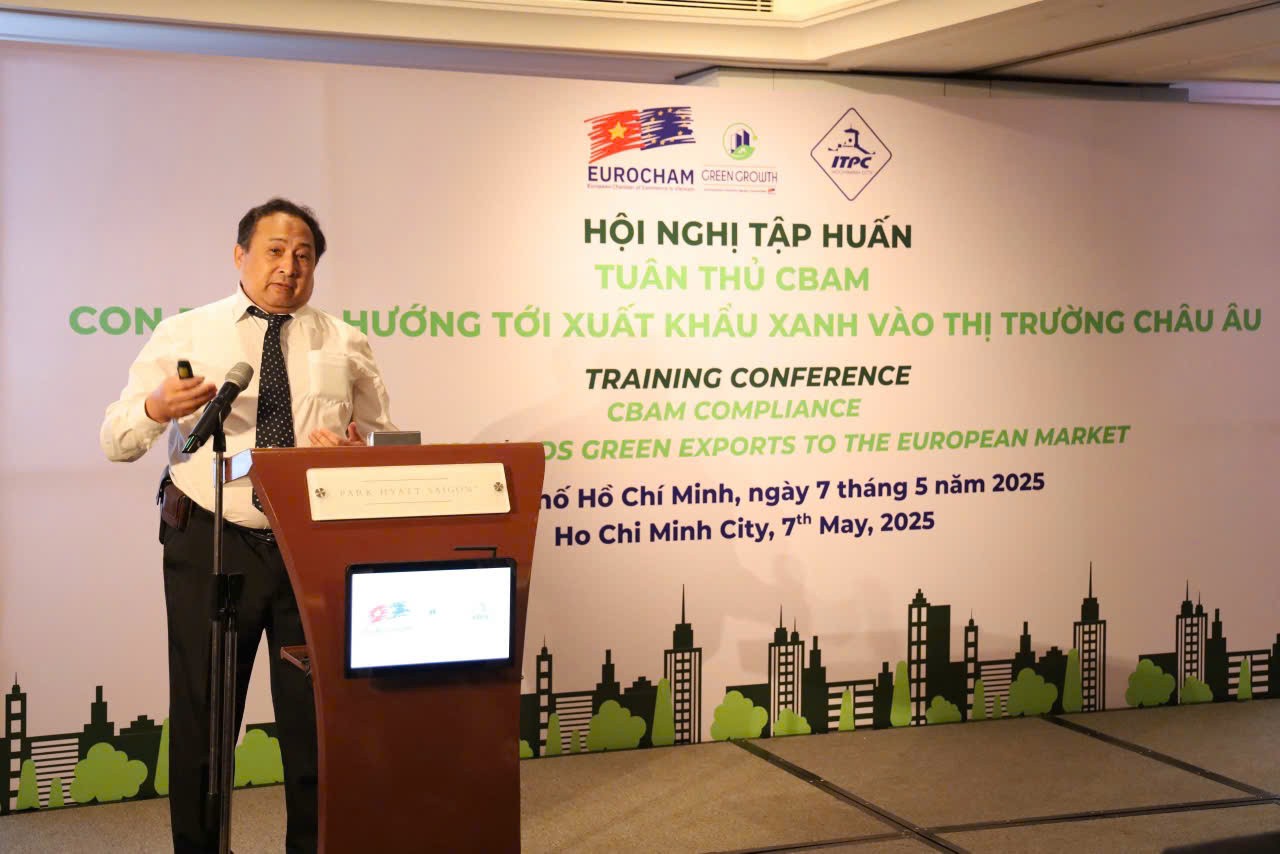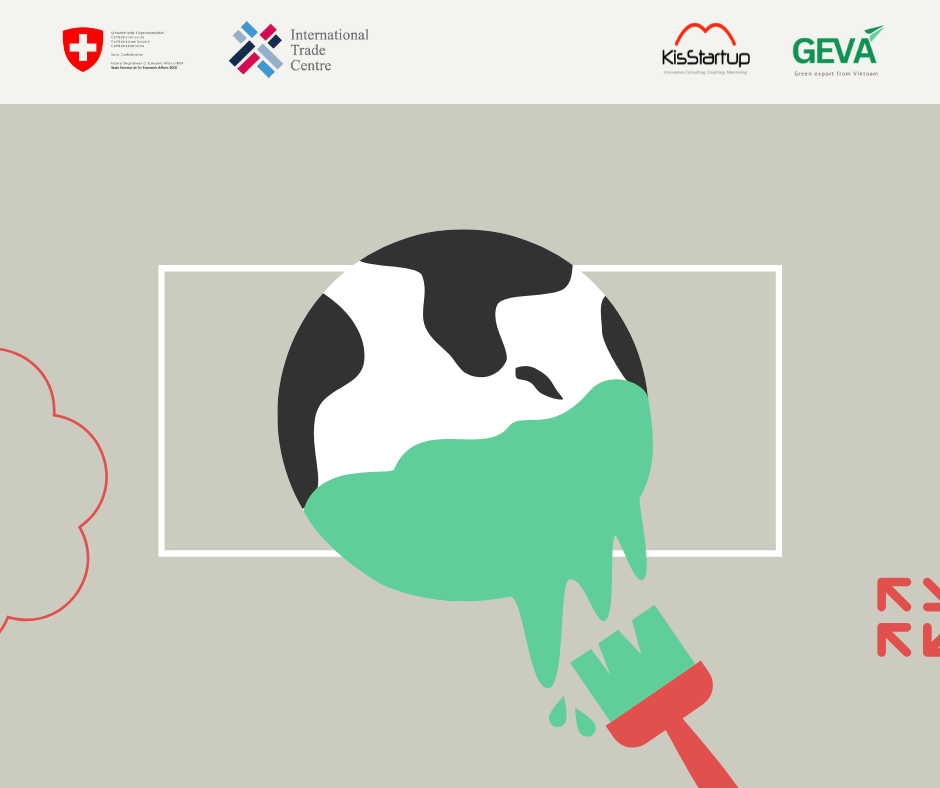quantri
Ngôn ngữ
Tabs
.
Tin tức liên quan

In the context of sustainable development becoming a global goal, green transformation is no longer an option but an inevitable trend. Especially with over 97% of businesses in Vietnam being small and medium-sized enterprises (SMEs), participating in this process not only enhances competitiveness but also ensures long-term development in the future.
Current Status of Green Transformation in Vietnamese Enterprises
According to a survey by the Private Sector Development Research Board (Board IV), up to 64% of Vietnamese enterprises have not implemented any actions related to green transformation. Most businesses are still in the stage of exploring the concept, without specific plans or clear solutions in place.
The main reason for this situation is the lack of investment capital — identified by 50% of businesses as the biggest challenge. In addition, other difficulties include a lack of suitable technical personnel, limited access to green technologies, scarce expert information, and challenges in meeting green credit criteria.
Digital Transformation as the Foundation, Green Transformation as the Goal
Experts suggest that green transformation is the next step in a business's development journey after digital transformation. Digital transformation acts as the foundation, enabling businesses to digitize data, automate processes, and optimize operations. With a solid foundation, businesses can effectively implement green solutions in a comprehensive and sustainable manner.
Understanding this relationship helps businesses be more proactive in adapting and better equipped to access and utilize green capital effectively, instead of passively seeking funding.
Building a Policy Ecosystem to Support Green Transformation
To ensure that green transformation happens consistently and effectively, Vietnam needs to quickly build a flexible policy ecosystem tailored to the characteristics of each type of enterprise.
First, it is crucial to establish a national Green Credit Guarantee Fund to help SMEs access preferential capital sources. At the same time, the list of green technologies eligible for import tax exemption or reduction — currently limited to only 54 items under the 2012 APEC agreement — should be reviewed and updated.
Standardizing product traceability systems through technologies such as blockchain and digital identity will enhance transparency and improve competitiveness in international markets. Moreover, support programs for green startups and innovation must be prioritized to create breakthroughs in areas like renewable energy, circular production, and sustainable agriculture.
What Should Businesses Do?
Green transformation cannot be a solo journey. Businesses need to be proactive in both mindset and action. First, they should build development strategies aligned with sustainability goals, practice green governance, and transition production processes toward environmental friendliness.
Additionally, businesses should actively seek green financing from both domestic and international sources, understand green credit criteria, and collaborate with financial institutions and support funds. Investment in technology, improving product quality, and developing socially responsible products are also essential steps.
Act Now – A Chance to Lead
This is a golden time for Vietnamese businesses to make a breakthrough by embracing and implementing green transformation. Being ahead of the curve not only boosts competitiveness but also opens doors to access demanding markets, where green standards are increasingly mandatory.
One specific support opportunity for businesses is the GEVA Project – Green Export Incubation and Acceleration Program through Voluntary Sustainability Standards (VSS), funded by the Swiss Government, managed by the International Trade Centre (ITC), and operated by KisStartup.
The project supports businesses to:
-
Self-assess capabilities through an online measurement tool
-
Participate in in-depth training programs on green exports and VSS
-
Be selected for a 6-month, customized 1:1 coaching package tailored to each business
Green transformation is an irreversible trend. The businesses that seize this opportunity will be the leaders of the future. Don’t wait — take action today to build a sustainable future for your business and for Vietnam’s economy.


In the coming years, Vietnamese businesses, especially in agriculture, will face major challenges from EU regulations: the Carbon Border Adjustment Mechanism (CBAM) and the EU Deforestation Regulation (EUDR). These are no longer future concerns—they require immediate action.
-
CBAM: From 2026, carbon taxes will be applied to imports into the EU unless companies can transparently report emissions. Many Vietnamese SMEs lack tools to measure or report emissions, risking contract loss or high tax penalties.
-
EUDR: From 2025, exports of forest-related products (e.g., coffee, rubber, cocoa) must prove zero deforestation post-2020 and full traceability through the supply chain. Non-compliance will result in exclusion from the EU market.
Failure to adapt will not only shrink market access but also risk exclusion from global supply chains. Meanwhile, international competitors are investing early in green tech and digital traceability, widening the gap.
Call to Action: Vietnamese firms must start now—measure emissions, standardize sustainable processes, and improve transparency.
One concrete solution: GEVA Project (Green Export Acceleration through Voluntary Sustainability Standards), funded by the Swiss government and managed by ITC and KisStartup. It offers:
-
Self-assessment tools
-
Green export & VSS training
-
6-month 1-on-1 business coaching

1. What is Greenwashing?
Many companies have made efforts to improve their environmental performance in order to meet customer and stakeholder expectations. However, the lack of clear verification rules and established standards has created ambiguity, making it possible for companies to exploit these gaps—or even be accused of greenwashing.
Greenwashing refers to practices, actions, or sustainability claims that do not accurately or fairly reflect the true sustainability profile of an entity, product, or financial service. Such misleading practices can deceive consumers, investors, or other market participants.
2. Types of Greenwashing
According to TerraChoice, a Canadian environmental consultancy, greenwashing can be categorized into seven “sins” in its report
“Sins of Greenwashing”, bao gồm:
-
Hidden Trade‑Offs: Sustainability claims based on a narrow set of attributes without considering other significant environmental issues. E.g., labeling paper as environmentally friendly because it is sourced from certified forests, while ignoring greenhouse gas emissions or chlorine bleaching processes.
-
No Proof: Claims that lack accessible data or credible third‑party verification—e.g., tissue or toilet paper labeled ‘post‑consumer recycled’ without clear evidence.
-
Vagueness: Using ambiguous terms like “all natural,” which can mislead—arsenic, uranium, mercury, and formaldehyde are all natural but extremely toxic.
-
False Labels: Claims or imagery suggesting third‑party certification when none exists.
-
Irrelevance: Environmentally true claims that are unhelpful or meaningless—e.g., “CFC‑free,” even though CFCs have been banned for nearly 30 years.
-
Lesser of Two Evils: Claims that may be true for one product category but distract from broader and more harmful industry-level impacts—e.g., organic tobacco.
-
Fabricated Claims: Purported environmental or sustainability claims without factual basis or certification.
3. Why Do Companies Greenwash?
Complying with ESG standards is not only a corporate responsibility toward society and the environment—it is also a key to attracting stakeholders such as:
-
Consumers: A 2021 study found 75% of Gen Z consumers prioritize sustainability over brand when making purchases. Sustainability is now a core element in marketing strategy and customer acquisition.
-
Employees: Many employees consider an organization's sustainability performance a critical factor in their career decisions—they expect clear commitments and meaningful action from their employers.
-
Investors: With ESG investing on the rise, companies are incentivized to portray themselves as “green” to attract like‑minded investors. IIA found sustainable indexes measuring ESG rose 43% in 2021
. Nghiên cứu của Aviva Investor and Aviva Investors reported that 9 in 10 institutional investors consider ESG when investing in real assets.
-
Regulators: Increasing regulatory requirements for sustainability disclosure and transparency create pressure for companies to follow through on and communicate their ESG commitments.
Importantly, not all instances of greenwashing are intentional. As a 2023 Google Cloud study revealed, many senior executives fear being accused of greenwashing despite having genuine intentions and goals. However, lacking the required planning or resources can lead to unintentional missteps.
4. Risks of Greenwashing
-
Reputational Damage: Accusations of greenwashing can erode consumer trust or trigger investor divestment. A 2020 Shift Insight report found 48% of respondents would limit their purchases from brands linked to greenwashing.(Báo cáo năm 2020 của Shift Insigh)
-
Legal Risks: Greenwashing may infringe regulatory requirements. For example, Deutsche Bank’s DWS asset manager agreed in September 2023 to pay a $19 million fine to the U.S. SEC over greenwashing allegations.
Additionally, on 17 January 2024, the European Parliament approved the “Green Consumer Empowerment Directive,” outlawing exaggerated or unsupported environmental claims—including carbon neutrality assertions. Although enforcement may take two years in the EU, this signals stricter scrutiny ahead for businesses in both EU and U.S. markets. -
Civil Litigation: Beyond regulatory enforcement, greenwashing—especially climate-related forms—is increasingly the subject of civil lawsuits..
5. How to Prevent Greenwashing Allegations
Although specific strategies may vary by industry, organization, or product, businesses should consider these best-practice measures:
GOVERNANCE
-
Policies and Procedures: Develop clear internal policies in collaboration with management, compliance, sustainability, risk, and internal audit teams. These policies should outline potential greenwashing risks and mitigation methods, including documentation and monitoring measures to provide evidence of compliance if accusations arise. Also, anticipate current and future legislation, greenwashing lawsuits, and enforcement actions.
-
Training: Educate employees at all levels about greenwashing risks, illustrating both positive and negative examples to ensure transparency and shared understanding.
-
Market Intelligence: Stay informed about evolving greenwashing incidents and regulatory trends. This helps you understand stakeholder expectations and complies with regulatory guidance.
DISCLOSURE
-
Clarity and Accuracy: Sustainability disclosures must be precise, clear, and understandable. Broad terms like “green” or “sustainable” should be clearly defined, evidence‑based, and verifiable. Avoid cherry‑picking positive data while ignoring negative aspects.
-
Address Gaps Between Claims and Actions: Any discrepancy between public claims and actual practices must be acknowledged and explained—these gaps are often central in enforcement actions.
-
Use Disclaimers for Forward‑Looking Statements: When making forecasts or commitments, use cautious and conditional language to mitigate claims of misrepresentation.
-
Avoid Exaggeration—Explain Conditions: Ensure sustainability claims are verifiable, and outline the conditions, assumptions, and calculations behind any claims.
-
Third‑Party Verification: Independent certification adds credibility and helps support sustainability claims.
-
Legal & Audit Review: All public ESG-related statements should be reviewed by legal counsel and/or audit teams.
DUE DILIGENCE
-
Review Current Claims: Regularly audit all public environmental or sustainability claims on labels, advertising, packaging, or digital media to ensure they are fact-based and justified.
-
Assess Feasibility of Future Commitments: Before making future ESG commitments, plan and model scenarios—including resource availability and technology considerations—to ensure you can realistically fulfill them.
-
Transaction Due Diligence: In transactions such as partnerships, investments, or acquisitions, evaluate the sustainability profile of the counterparty, including supply chain compliance and reputation alignment with your organization’s sustainability strategy.
In Summary
With greenwashing increasingly in the spotlight of regulators and international stakeholders, businesses face mounting pressure to genuinely act and prove their environmental commitments. Government regulations and litigation are raising the stakes: companies no longer have the luxury of making exaggerated or unsupported sustainability claims. Strict compliance and transparent communication not only help avoid legal, reputational, and financial risks, but also demonstrate sincerity in building a sustainable future for our planet and future generations.

Amidst the global push for stronger environmental policies, Vietnam’s key export sectors such as textiles and garments, footwear, steel, and electronics are facing increasing pressure from green regulations, carbon taxes, and carbon traceability requirements.
According to an article published by VnEconomy, markets like the European Union and the United States have begun implementing policies such as the EU Carbon Border Adjustment Mechanism (CBAM) expected to take effect in 2026, green passports for textile products, and mandatory carbon traceability for imported goods. These regulations are not just technical barriers—they directly impact the competitiveness of Vietnamese products in the global marketplace.
Minister of Industry and Trade Nguyễn Hồng Diên emphasized that after 15 years of implementation, the Law on Economical and Efficient Use of Energy has revealed certain limitations and now needs to be revised to better address emerging green policy challenges such as carbon emission taxation, carbon border adjustments, and carbon footprint tracking.
The lack of financial mechanisms to support businesses in complying with green requirements has made it harder for Vietnamese goods to remain competitive in export markets.
To tackle these challenges, Vietnam must consider revising the law to strengthen enforcement mechanisms and shift from voluntary to mandatory energy efficiency regulations. At the same time, it is essential to mobilize resources to support businesses in transitioning toward green and sustainable production, in line with the evolving demands of international markets.
Join the GEVA Project to kick-start your journey toward green transformation today by registering via the link below:
FORM ĐĂNG KÝ THAM GIA CHƯƠNG TRÌNH ĐÀO TẠO - XÚC TIẾN XUẤT KHẨU XANH.
Turn challenges into opportunities – embrace sustainable transformation to reach further in global markets!
